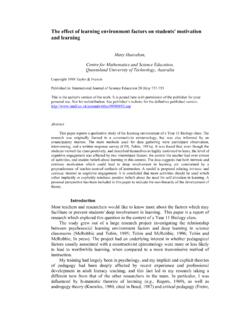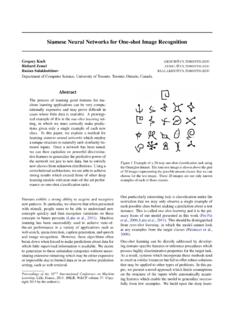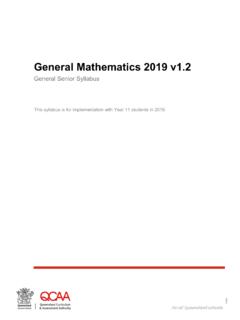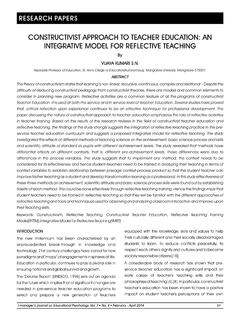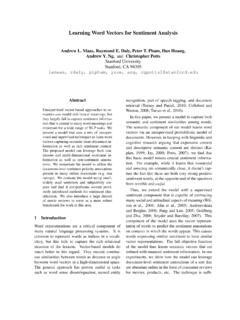Transcription of 1 Adult Development and Learning of Older Adults - ed
1 1 Adult Development and Learning of Older Adults Donald N. Roberson, Jr., PhD. Rivers Crossing, Adult Education University of Georgia Athens, GA 30605 Abstract This summary of Adult Development covers a wide range of authors. Adult Development is one way of understanding how the internal and external changes in our lives have an impact on Learning . Of particular importance in this work are the developmental issues of Older Adults . I present various theories of Adult Development such as linear and integrated. The impact of the physical dimension of one s life is discussed. Also the writings of several authors are presented such as Erikson, Havighurst, Peck, Fisher, Baltes and Baltes, and Kleiber.
2 Learning is often the result of the stage of life of the person. 2 Adult Development and Learning with Older Adults Introduction There is an appointed time for everything. And there is a time for every event under heaven. A time to give birth, and a time to die. A time to plant, and a time to uproot what is planted. (Ecclesiastes 3: 1 3, New American Standard Bible). From Solomon s description of a person s time in the book of Ecclesiastes, to Shakespeare s reference to the stages of life in As you like it , people have been attempting to make sense of the different periods of one s life. All the world s a stage, and all the men and women merely players; they have their exits and their entrances; and one man in his time plays many parts, his acts being seven ages.
3 (As You Like It, Act II, Scene 7, 139) (as cited in Erikson, 1997). Development of the person is a lifelong process from cradle to grave with each period or time equally important, yet inherently different. This process traces the complex dynamics of change throughout the human life. Developmental tasks are links between the demands of society and one s individuals needs (Havighurst, 1972). This human metamorphous at first seems to be physical, yet beneath the surface there are complex mental and emotional changes that comprise the life of each person (Hoyer, Rybash, & Roodin, 1999). Solomon suggests each appointed time is equal, yet Shakespeare places men and women on a downward spiral.
4 Last scene of all, that ends this strange eventful history, is second childishness and mere oblivion, sans teeth, sans eyes, sans taste, sans everything. (As You Like It, Act II, Scene 7, 139) (as cited in Erikson, 1997). A more modern synopsis of these changes is seen in Merriam and Caffarella s (1999) explanation of Development as sequential, life event, and integrative. Sequential 3models of Development are a linear perspective, focusing on how Development occurs within the individual during their lifetime. Erikson s ego Development (1950), Havighurt s teachable moment (1972), Levinsons s self Development , Loevinger s integration, Neugarten s social clock, Perry s ethics, Kohlberg s moral Development , and Fowler s faith Development offer insight to the changing nature of the internal self as one develops and changes (as cited in Merriam & Caffarella).
5 These stages are a series of sequential changes within the individual across the lifetime, and these important findings have wide spread influence and popularity (Hoyer et al. 1999). These sequential or stage theories help to order the daily chaos in one s life, yet life event and integrative models may be more diverse and inclusive. Life event and transition theories have received greater attention in the last few years. Schlossberg, Sugarman, and McClusky suggest these life events with its accompanying transitions are significant times or benchmarks in the person s life (as cited in Merriam & Caffarella, 1999). Likewise, Gould (as cited in Schulz & Salthouse, 1999) states that major changes in one s life include specific events such as marriage or burying one s parents and give shape and direction to the unique aspects of one s life.
6 Schlossberg (as cited in Merriam & Caffarella) has labeled these as anticipated, unanticipated, non-eventful, or sleeper events that seem to spring from one s internal clock. These life events also provide opportunities within the life cycle for Learning (Lamdin, 1997). The integrative perspective on Adult Development acknowledges the intersection of biological, psychological, and socio-cultural perspectives. This view especially recognizes the complex and integrated role of the various dimensions on one s 4development. Looking beyond the individual to the context of one s life is considered essential, this life-wide view of Adult Development is interactive and multi-causal (Merriam & Caffarella, 1999).
7 This contextualization leads to plasticity, historical embeddedness, and a multidirectional approach. This contextual paradigm ties the current situation of the Adult to the many layers of one s life. This somewhat dialectical view allows for chaos and contradiction within the various dimensions of one persons life (Baltes & Baltes, 1990; Hoyer et al. 1999). Physical dimension of Adult Development The psychological aspects of Adult Development can be better understood with a perspective on the physical dimension. Many of the changes and adaptations within the person are the result of physical changes in the body (Peck, 1956).
8 Piaget s work with children attests to the normal physical Development of the body and its implications, especially cognitive response to the changing physical dimensions of the body (as cited in Feldman, 2000). Continuing these thoughts, the European oriented Fourth Stage of Development is dedicated to the stage in life when the demands of the body become pre-eminent (Lamdin, 1997). Also, Jarvis (2001) sets the theme of his research on redirecting one s biography against the background of personal physical changes and one s ensuing adaptations. It is natural for the Older Adult to experience physical changes, yet perhaps the word degenerative is too negative.
9 Some of the stereotypes and misunderstandings of Older people are the result of confusing normal aging with actual disease (Baltes & Baltes, 1990; DiGiovanna, 1994; Quadagno, 1999). Many of the physical changes of Older Adults involve changes in the nervous system, such as sleep patterns, dulling of 5senses, lessening of secondary memory, and less problem solving ability. Yet unless one has dementia, such as Alzheimer s, or a chronic health condition, the Adult can negotiate these problems. Research has indicated the value of training, physical exercise, mental exercise, and social support in adjusting to these normal physical changes (Bee, 1998; Dunn, Anderson, & Jakicic, 1998; Haskell, 1994; Haskell & Phillips, 1995).
10 Older Adults Gerontologists display staggering statistics that reflect an aging population across the globe. For example, currently there are 61,000 Adults that are centenarians in the USA, yet by 2020 the predication is that there will be 214,000 (Feldman, 2000). In order to be prepared to adapt to this graying demographic, there is a need to learn more about the changes in Older Adults . Erikson (1950, 1986, 1997), Havighurst (1952), Peck (1956), Fisher (1993), Baltes and Baltes (1990), and Kleiber (1999) will be discussed as appropriate for understanding Older Adults . Erikson. Adult Development theory acknowledges the pervasive influence of Erikson s (1950, 1986, 1997) ideas.










